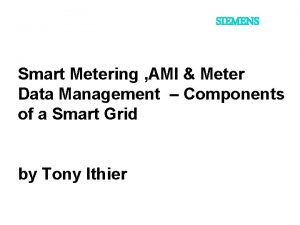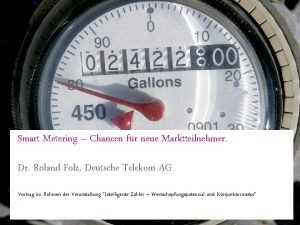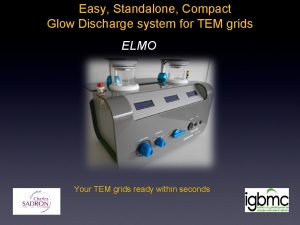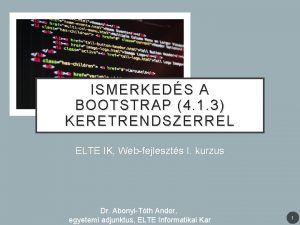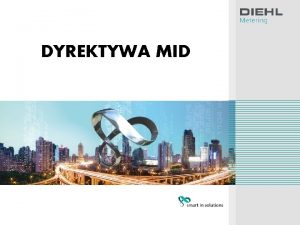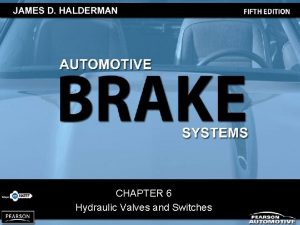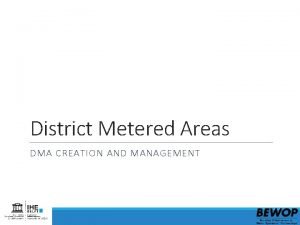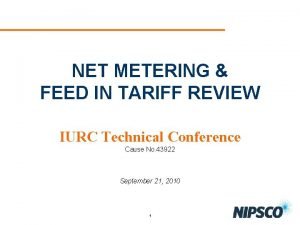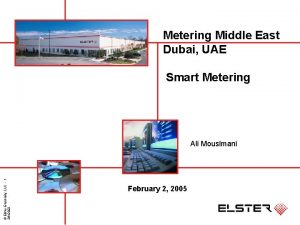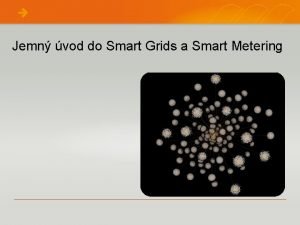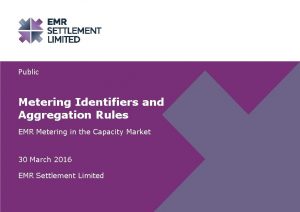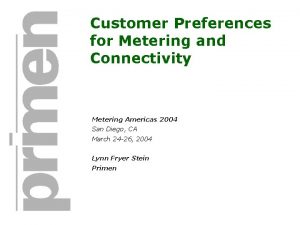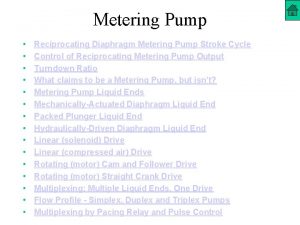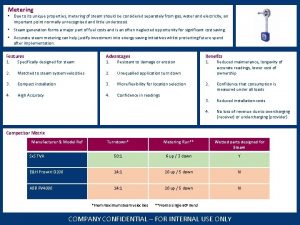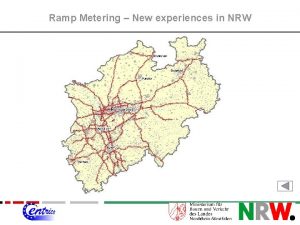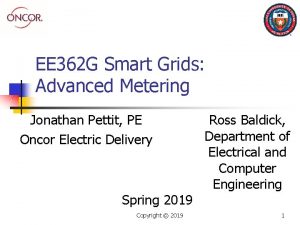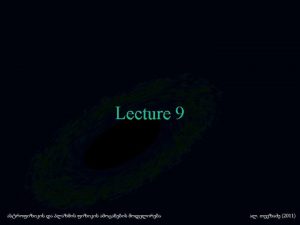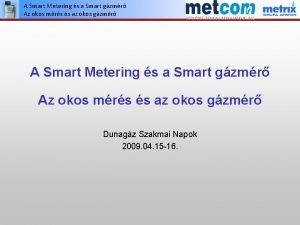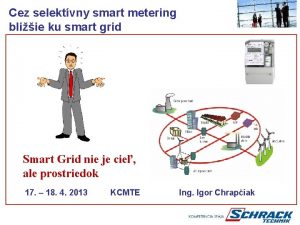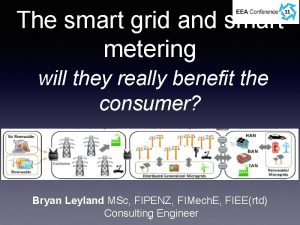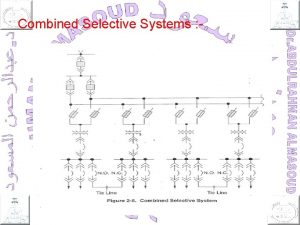Through a selective Smart Metering towards Smart Grids







































- Slides: 39

Through a selective Smart Metering towards Smart Grids Smart Grid is no target but an instrument 17. – 18. 4. 2013 KCMTE Ing. Igor Chrapčiak

The World is changing. . . New conditions, changes and interrelations: Population growth: Movement of population to cities, increased standard of living, demands for comfort, growing energy intensity followed by crises Environment pollution, high production of CO 2, smog and exhaust gases, undesirable health consequences, global warming High dependence on fossil fuel sources and their possessors Big centralised power sources, long-distance transmission lines, risk of loss of value of vast territories and loss of many people at outages, risk of "blackouts" Renewable energy sources, local and time-dependent oversupplies and shortages of power Planned e-mobility Undesirable new phenomena in power grids Investment and economic interests. . .

Development in Power Industry – Smart Grid Efforts of EU countries to adopt reasonable measures for making energy processes more effective with regard to the environment, safety and stability of power transmission, controllability, minimisation of operating costs, efficiency, customer satisfaction… Rules 20/20/20: Smart Grid notion Smart Production (Smart power generation), consisting in addition of smaller distributed energy resources, e. g. Renewable Energy Sources (RES) or Combined Generation (of power and heat - Co. Gen), to classical big power stations… In short: Decentralised power generation with a suitable mix of sources Smart Distribution, consisting in recognition and control of grid conditions at all voltage levels and transformer stations, with two-way flows of power in lines, active self-control ability, optimised transfer, reduced losses, increased efficiency… Smart Consumption, consisting in optimisation of power consumption, including households, Smart appliances, control, e-mobility, Smart Home, Smart Cities

Slovak Republic - Act on Power Industry No. 251 of 31. 7. 2012 § 42 Intelligent Metering Systems (IMS) The Ministry, in cooperation with the Authority, Operators of regional distribution systems and other participants in the market with power, shall elaborate the Analysis of economic benefits resulting from the implementation of various versions of Intelligent Metering Systems (IMS) and costs for their procurement, installation and operation for appropriate categories of end consumers On the basis of such Analysis, it determines the categories of end power consumers and imposes the duty to implement IMS in at least 80% of consumption points pertaining to each individual category Participants in the market with power shall collaborate with PDS in exerting cooperation at the installation and operation of IMS by the way and under the conditions as stipulated in Sect. § 95.

It has been decided… The Ministry (MHSR) decided in September 2012, in cooperation with ÚRSO and on the basis of analyses, that it will be economically effective under current conditions to implement IMS at all consumption points with the annual power consumption higher than 4, 000 k. Wh. The overall annual power consumption at those consumption points represents approx. 53% of the total consumed power at the LV level and those consumption points represent approx. 23% of the total consumption points at the LV level. It results from the pilot projects and related data concerning real costs and benefits, with consideration of possible development of respective technologies, that the actual scenario may have to be updated after two years. Further progress and functionalities of the system shall be specified by MHSR in cooperation with an expert group in compliance with Sect. § 95 of the Act No. 251/2012 (not later than on 30. 6. 2013).

How to do that? Act on Power Industry No. 251 of 31. 7. 2012 Sect. § 95 Authorising provisions h) The Ministry shall issue a generally binding legal regulation which will include the following items concerning the implementation and operation of IMS according to Sect. § 42: • 1. Criteria and conditions for the implementation of IMS for the individual categories of end power consumers, • 2. Deadlines for the implementation of IMS for the individual categories of end power consumers at which it seems to be reasonable to implement IMS within the next 10 years, • 3. Requirements for the cooperation of individual participants in the market with power in the installation and operation of IMS, • 4. Required technical parameters of IMS, • 5. Requirements for data transfers and cooperation of individual systems, • 6. Method of access to data collected by IMS from the side of individual participants in the market with power,

Other relations – Act No. 251/2012 Optional regulation of power consumption Sect. § 31 Rights and duties of Distribution System Operator (DSO) p) The Distribution System Operator is obliged to install Intelligent Metering Systems in accordance with Sect. § 42 q) The Distribution System Operator is obliged to ensure the installation of appropriate equipment for the continuous metering of consumed power with possible remote reading from respective point of consumption, namely at the moment of replacement of designated electricity meter, and for a new point of consumption in case of fulfilment of respective conditions in accordance with market rules*. f) The Operator has right to equip respective point of consumption with a technical device regulating the quantity of consumed power

Other relations – Act No. 251/2012 Measurement of power quality parameters § 31 Rights and duties of Distribution System Operator (DSO) Subsect. 1, Par. e, Subpar. 8. , Subpar. 9. : Distribution System Operator has right: to reduce or discontinue power distribution to an inevitable extent and for an inevitable period of time, without liability for indemnification except of those cases when a damage has arisen due to the fault of Distribution System Operator, when. 8. such power has been consumed by facilities which influence the quality and reliability of power supply and when respective power consumer has not ensured the limitation of such influences by any available technological means 9. such power has been generated by facilities which influence the quality and reliability of power supply and when respective power producer has not ensured the limitation of such influences by any available technological means.

(Expected) secondary legislation to the Act No. 251 - regulations to implement this Act Executive regulation for Intelligent Metering Systems (2013) Definition of goals, requirements and parameters for the implementation (of IMS), definition of pilot project, safety requirements, requirements on national communication standards, guarantees for interoperability Regulation ÚRSO (No. 3/2013) which determines the method, extent and structure of provision of data on power consumption to the power consumer at the point of consumption and storage of such data Regulation No. 24/2013 Market rules which determines the collection and administration of data on power consumption and related invoicing performed by the organiser of short-term market with power Regulation No. 275/2012 ÚRSO of 5. 9. 2012 which determines the standards of power quality Metrology, safety, protection of personal data. . .

Our principal goals – IMS+ Analysis of output and qualitative parameters of LV grid, analysis of losses, revealing of reserves Prevention of fault conditions and outages Improved control and shifting of peak power consumption Equalisation of balance between power consumption and generation in the area of interest Resolution of issues connected with Renewable Energy Sources (RES): instability, surplus or shortage of power which is often generated in an unsuitable period of time, depending on hardly predictable external influences Reduction and optimisation of power transmission Improvement of qualitative power supply parameters Reduction of losses and improved efficiency

How to be Smart? 1. No grid can be Smart or no grid can even exist without Smart Metering. 2. It would be ineffective or almost useless, if we implement Smart Metering without actually building up Smart Grid. 3. All that would be useless, if the metering is incorrect and incomplete

Daily profiles of power generation and consumption from fotovoltaic sources There are efforts to equalise the balance of power generation [green curve] and consumption [blue/red curve] or to "shave" peaks of consumption. Peaks of power generation and consumption occur at different times

Elimination of negative influences of Renewable Energy Sources (RES) (USUAL) SUPPLY OF DTS FROM SUPERIOR GRID (HV) DISTRIBUTION TRANSFORMING STATION (DTS) USUAL HOUSEHOLD CONSUMPTION UNCONTROLLABLE Municipality, locality CONSUMPTI ON Hot water heaters CONTROLLABLE Heat storage appliances Batteries (for e-vehicles) Dishwashing / washing machines, tumble dryers POWER GENERATION (RES) Small Fotovoltaic PG sources Given configuration of PG sources and power consumption induces a non -standard flow of power from LV grid to HV grid in peaks (up to 65% of the output) This negative impact could be possibly eliminated by switching-on suitable heat storage appliances or heaters

A stand-by household - an example Appliance "digital clocks" Satellite receiver PC set notebook chargers LCD TV Hi. Fi player DVD/CD record player Total 1 household Total Slovakia items % of non-use P S A(P)/year [W] [VA] [k. Whr] 2 100% 10 20 175 2 60% 12 20 126 2 50% 10 25 88 1 60% 5 15 26 5 80% 2 20 70 2 60% 1 22 11 2 90% 15 30 237 1 90% 10 15 79 811 [MWhr] 30 % ? Number of households: 1, 898, 000 1 539 612 461 883 Sum A(S)/year [€] [k. VAhr] 21 350 15 210 11 219 3 79 8 701 1 231 28 473 9 118 97 2382 4 521 036 1 356 310

Are we metering correctly? Current is “contaminated” and asymmetric Deformation due to a phase shift and higher harmonics Current is composed not only of the first harmonics but also of higher harmonics, there is a phase shift between current and voltage and a three-phase system is often asymmetric

Are we metering correctly? Apparent power and other sorts of power Obviously: S = U. I over - undesirable 1 st term – active power P. The unit of P is watt. Customer pays for such power. 2 nd term – reactive power Q. The unit of Q is var. Customer sometimes pays for such power in the form of surcharge or penalty. 3 rd term – distortional power D. The unit of D is VA. Nobody pays for such power, nor is penalised for it.

Let us not neglect the future! Power factor P/S (PF), losses Power = total power S Wattless (reactive) power Q Active power P Asymmetry N Distortional power D

PF is not the same as cosφ (even if it sometimes is. . . ) It is prescribed in the pricelists of power distribution for monthly invoiced customers to monitor also "the power factor or cos φ" which must be within the limits 0. 95 to 1. When this condition has not been satisfied, the customer is penalised by a tariff surcharge, a percentage surcharge to the tariff price for the distribution. We should realise that cos φ in this case represents just a phase shift of the first harmonics u and i, which is defined by means of tg φ as a ratio Q/P and does not represent a real "power factor" which is understood to be the ratio of watt and wattless power in a periodic mode: . PF = λ = P/S (i. e. not cos φ) The notion "phase shift" φ, or "power factor" cos φ can be used only for the harmonics u and i. For non-harmonic cycles, we should use PF, i. e. P/S

Losses – loss increase coefficient kz, P/S Undesirable increase of losses is characterised by loss increase coefficient kz – it indicates how many times are respective losses higher than minimally possible losses for a given power output. or, after re-arrangement: If kz >1, then (undesirably) we consume power also for phase shifting, generation of higher harmonics and asymmetry. 3 principal factors which need to be analysed and their influence minimised: Magnitude of wattless power Q, measurement of Q 1 and cos φ Magnitude of distortional power D, measurement of S and higher harmonics of U, I Magnitude of asymmetry, measurement of U and I in a three-phase system

Cos φ and P/S (Monthly monitoring 10/2012, weekend 6 – 7 / 10) cos(φ) – measured according to power industry usage, it includes the influence of Q P/Sa ("cos" Sa) – measured with the help of arithmetic apparent power, it includes the influence of Q, D P/Sr ("cos" Sr) – measured with the help of correct apparent power, it includes the influence of Q, D and, in a three-phase system, also asymmetry N All measurements are cumulative, i. e. on the basis of energy, not output

Analysis of DTS loading - values P, Q, S from LZQJ-XC processed in EDW TS : PA_1007 – Rosice nad Labem [CZ], 400 k. VA Maximum 78, 4 k. W- 28. 12. 2012 12, 00 Minimum 17, 6 k. W- 26. 12. 2012 03, 45

What we have measured. . . Table report of performance Evaluated period: from - to 2 6

Asymmetry of current – low PF value Losses in DS – linear 3 -phase arrangement

Improved asymmetry of current – standard PF value Losses in DS – linear 3 -phase arrangement

How it is in reality? Example of an administrative building Situation in an administrative building

How it is in reality? Example of a family house Situation in a family house

How it is in reality? Example of a family house Situation in a family house

Fotovoltaic power generation sources (FVE) – measured results

Losses in lines "Good" Imin and “Bad" Inad current Total losses in lines “over-losses" in lines Minimum possible losses in lines Losses caused by the passage of electric current through a conductor are inevitable. They can be optimal or higher than that. They are optimal, if they have a minimum possible value at a given transmitted power output – minimum losses occur when P=S.

How much are losses changing? The increase of P/S from 0. 85 to 0. 92 e. g. means that the real losses decrease by 20 % of the magnitude of minimum possible losses

Graphical expression of change How much will losses change? Let us try to improve P/S % originally 0. 9

Let us seek common benefits and opportunities, functionalities and data Data for power consumers Data for grid administrators and operators Data for power suppliers and traders Data for dispatching system and producers Data for higher-level system Data for other participants in market with power Sources for: Analysis of grid condition Optimisation of switching Improvement of efficiency and reduction of losses Resolution of undesirable and fault conditions Support of integration and control of Renewable Energy Sources Support of e-mobility. . .

Smart Metering – let us seek common benefits and opportunities Bidirectional communication with points of metering Information on actual power consumption and history of power output consumption in time, to be available even for consumers – through websites, home displays, SMSs or TV sets Optional automatic remote reading as of the defined date and time, in regular intervals (e. g. monthly) or on prompt demand (stopreading, contractual modifications. . . ) Optional remote disconnection and reconnection of consumers Limitation of agreed power output (tariff change-over, limitation of output, prepaid services. . . ) Checks of unauthorised tampering Optional monitoring and analysing of grid operation parameters Optional input for data from metering of other utilities in the future (gas, water, heat. . . - with exploitation of existing data transfer and communication channels)

Smart Metering – let us seek common benefits and opportunities Accurate and more frequent metering – more accurate and detailed information on consumer behaviour with regard to energy and planning More accurate specification of reserved capacity, reduction of deviation More accurate prediction – possible better prices for power (? ) Sources for creation of new trading products and motivating, effective or social tariffs Information on outages and other problems in grids, on alarms and tampering Refinement (or replacement) of TDO, possible complement / replacement of HDO Necessary data for future smart grids a development of e-mobility Enlargement of possibilities for deployment of RES, sources for effective control of power generation units and decentralised power supply in localities Elimination of negative impacts and influences from deployment of RES Support of resolution of possible emergency condition and many other opportunities. . .

Smart Metering – let us try to resolve drawbacks, risks and threats Uncertainty of real benefits and return on investment High one-time costs, unclear financing Challenging communication and IT solutions Absence of standards, questionable reliability of the system Unknown (high) degree of vulnerability and lability of the system Necessity of complicated coordination, logistic and organisation structures Questionable relationship of customers to the project, condition of installations and switchboards Legal aspects of data security and personal data protection Unclearly defined requirements of future Smart Grids Complicated interoperability of metering systems and devices Questionable benefits of control technology in relation to HDO Insufficiently prepared legislation, etc…

We are starting…

Monitoring DTS outages Live assembly

Possible design of a switchboard for SG in DTS GPRS SIEM electricity meter LZQJ-XC UPS RS 485 AIL 09 – Device for monitoring of outages of transforming station outlets Signal input Smart Grid Powerline Concentrator Thermometer L+G meter ZPA Meter & Control Mikroelektronika L+G NA meter Meter IUSA Meter L+G Brazil Meter

Thank you for your attention… Do we want to be ready also for the future? Performance factor P/S i. chrapciak@schrack. sk
 Demand response in smart grids
Demand response in smart grids Ami rotary dials
Ami rotary dials Decc smart metering implementation programme
Decc smart metering implementation programme Smart metering telekom
Smart metering telekom Classification of adrenoblockers
Classification of adrenoblockers Decimal using grids
Decimal using grids Differentiation grids
Differentiation grids Grid radius radiology
Grid radius radiology Parallel research kernels
Parallel research kernels Glow discharge system
Glow discharge system Salary grids
Salary grids Layered architecture for web services and grids
Layered architecture for web services and grids Bootstrap 4 osztály
Bootstrap 4 osztály Mt carmel electric net metering
Mt carmel electric net metering Advantages of cipoletti weir
Advantages of cipoletti weir Mid directive
Mid directive Multicircuit meters
Multicircuit meters Ueeneeg171a
Ueeneeg171a Sage metering
Sage metering Ameren net metering
Ameren net metering Fpl net metering agreement
Fpl net metering agreement Net metering punjab
Net metering punjab A combination valve includes
A combination valve includes Surefire metering tube chart
Surefire metering tube chart Odisha net metering policy
Odisha net metering policy District meter area design
District meter area design Nipsco net metering
Nipsco net metering Sage metering
Sage metering Advantage of through and through sawing
Advantage of through and through sawing Through one man sin entered
Through one man sin entered The night of the scorpion by nissim ezekiel
The night of the scorpion by nissim ezekiel Furcation involvement classification
Furcation involvement classification It's not how smart you are it's how you are smart
It's not how smart you are it's how you are smart Street smart vs book smart quotes
Street smart vs book smart quotes Investing in you future smart answers
Investing in you future smart answers One smart man he felt smart
One smart man he felt smart Street knowledge vs book knowledge
Street knowledge vs book knowledge It's not how smart you are
It's not how smart you are One smart man he felt smart
One smart man he felt smart Street smart vs book smart quotes
Street smart vs book smart quotes

